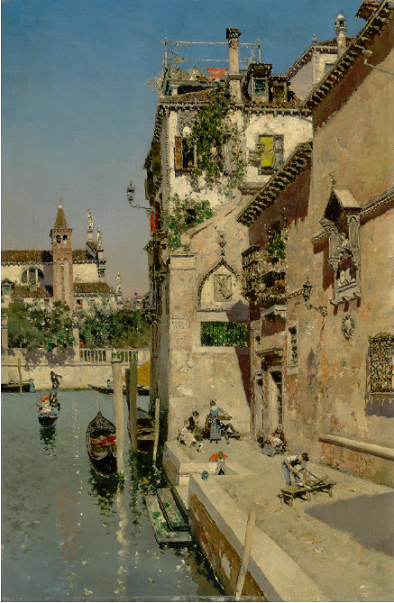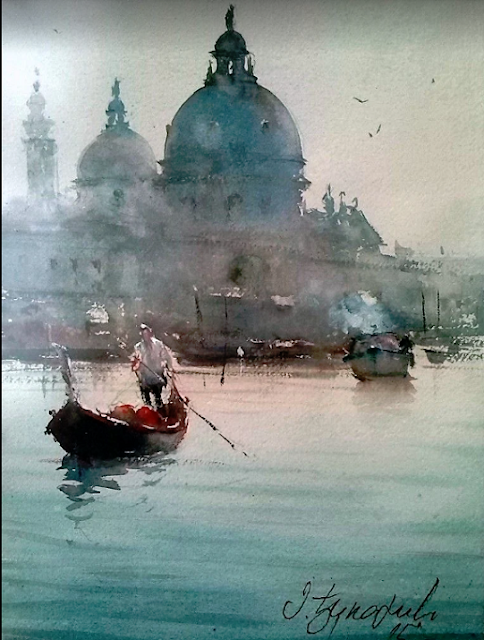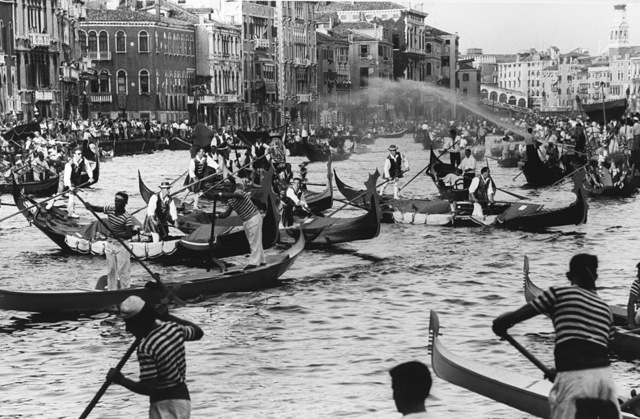01 Painting of the Canals of Venice, with foot notes. #75
Martín Rico y Ortega, 1833 - 1908, SPANISH
VENETIAN CANAL, SAN VIDAL IN THE DISTANCE
Oil on canvas
28 1/4 by 18 5/8 in., 71.8 by 47.3
Private collection
San Vidal is a former church, and now an event and concert hall located at one end of the Campo Santo Stefano in the Sestiere of San Marco, where it leads into the campiello San Vidal, and from there to the Ponte dell'Accademia that spans the Grand Canal and connects to the Sestiere of Dorsoduro, Venice, Italy.
The church at the site was erected in the year 1084 by Doge Vitale Falier. The facade (1734–37), designed by Andrea Tirali, is sculpted portraits of the Doge Carlo Contarini and his wife Paolina.
At present in 2018, the church is deconsecrated, and the chamber music group Interpreti Veneziani performs concerts at the church. More on San Vidal
Martín Rico y Ortega (12 November 1833, El Escorial –
13 April 1908, Venice, Italy) was a Spanish painter of landscapes
and cityscapes. Rico was one of the most important artists of the second half
of the nineteenth century in his native country, and enjoyed wide international
recognition.
Rico was
born in Madrid and received his earliest formal training at the city’s Real
Academia de Bellas Artes de San Fernando, where he studied under Jenaro Pérez
Villaamil. In 1860, having been awarded a government-sponsored scholarship,
Rico moved to Paris to continue his studies.
His
landscapes depict the French and Swiss countryside in a fully accomplished
Realist style. Toward the end of 1870, due to political and social unrest
caused by the outbreak of the Franco-Prussian War, Rico decided to leave France
and return to his native Spain.
Rico moved to the southern city of Granada, joining Fortuny
and his wife Cecilia, as well as the painter Ricardo de Madrazo. The three
artists worked closely during this period, with the styles of Rico and Fortuny
overlapping so much that their watercolors—a specialty for both artists—were
often confused for one another. It was during this time that, through Fortuny’s
influence, Rico’s paintings began to reveal a newfound sense of luminosity and
color. His time in Andalucía was, according to his memoirs, one of his
happiest, and also one of his most artistically productive periods. More on Martín Rico
y Ortega
Please visit my other blogs: Art
Collector, Mythology, Marine
Art, Portrait of a Lady, The
Orientalist, Art of the Nude and The
Canals of Venice, Middle
East Artists, and visit my Boards on Pinterest
Images are copyright of their
respective owners, assignees or others. Some Images may be subject to copyright
I don't own any of these images -
credit is always given when due unless it is unknown to me. if I post your
images without your permission, please tell me.
I do not sell art, art prints, framed
posters or reproductions. Ads are shown only to compensate the hosting
expenses.
If you enjoyed this post, please share
with friends and family.
Thank you for visiting my blog and also
for liking its posts and pages.
Please note that the content of this post primarily consists of articles
available from Wikipedia or other free sources online.



Comments
Post a Comment